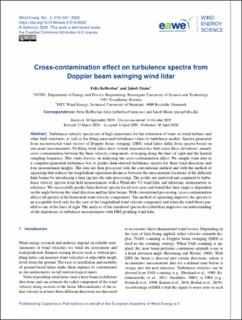| dc.contributor.author | Kelberlau, Felix | |
| dc.contributor.author | Mann, Jakob | |
| dc.date.accessioned | 2020-05-20T12:03:08Z | |
| dc.date.available | 2020-05-20T12:03:08Z | |
| dc.date.created | 2020-04-30T12:05:17Z | |
| dc.date.issued | 2020 | |
| dc.identifier.issn | 2366-7443 | |
| dc.identifier.uri | https://hdl.handle.net/11250/2655179 | |
| dc.description.abstract | Turbulence velocity spectra are of high importance for the estimation of loads on wind turbines and other built structures, as well as for fitting measured turbulence values to turbulence models. Spectra generated from reconstructed wind vectors of Doppler beam swinging (DBS) wind lidars differ from spectra based on one-point measurements. Profiling wind lidars have several characteristics that cause these deviations, namely cross-contamination between the three velocity components, averaging along the lines of sight and the limited sampling frequency. This study focuses on analyzing the cross-contamination effect. We sample wind data in a computer-generated turbulence box to predict lidar-derived turbulence spectra for three wind directions and four measurement heights. The data are then processed with the conventional method and with the method of squeezing that reduces the longitudinal separation distances between the measurement locations of the different lidar beams by introducing a time lag into the data processing. The results are analyzed and compared to turbulence velocity spectra from field measurements with a Windcube V2 wind lidar and ultrasonic anemometers as reference. We successfully predict lidar-derived spectra for all test cases and found that their shape is dependent on the angle between the wind direction and the lidar beams. With conventional processing, cross-contamination affects all spectra of the horizontal wind velocity components. The method of squeezing improves the spectra to an acceptable level only for the case of the longitudinal wind velocity component and when the wind blows parallel to one of the lines of sight. The analysis of the simulated spectra described here improves our understanding of the limitations of turbulence measurements with DBS profiling wind lidar. | en_US |
| dc.language.iso | eng | en_US |
| dc.publisher | Copernicus Publications | en_US |
| dc.rights | Navngivelse 4.0 Internasjonal | * |
| dc.rights.uri | http://creativecommons.org/licenses/by/4.0/deed.no | * |
| dc.title | Cross-contamination effect on turbulence spectra from Doppler beam swinging wind lidar | en_US |
| dc.type | Peer reviewed | en_US |
| dc.type | Journal article | en_US |
| dc.description.version | publishedVersion | en_US |
| dc.source.journal | Wind Energy Science | en_US |
| dc.identifier.doi | 10.5194/wes-5-519-2020 | |
| dc.identifier.cristin | 1808825 | |
| dc.description.localcode | © Author(s) 2020. This work is distributed under the Creative Commons Attribution 4.0 License. | en_US |
| cristin.ispublished | true | |
| cristin.fulltext | original | |
| cristin.qualitycode | 1 | |

